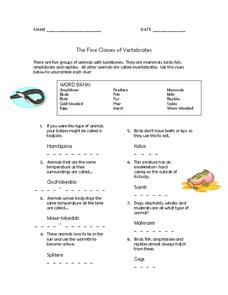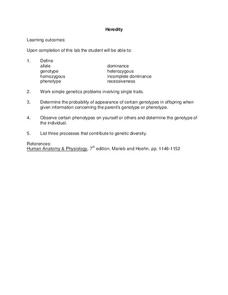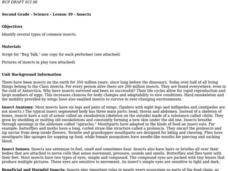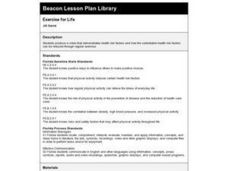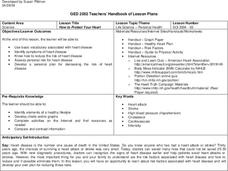Curated OER
Antibodies
Students conduct a series of exploration activity on how vaccines and antibodies work. In this biology lesson plan, students test how antigens and antibodies work in the body. They discuss the benefits of vaccines in promoting immune...
Curated OER
Cardiac Arrest! Using Forensics to Investigate Cardiovascular Anatomy and Function
Students identify the different parts and functions of the cardiovascular system. In this forensics lesson, students collect and analyze evidence on a fictional crime. They describe different causes of cardiac arrest.
Curated OER
The Five Classes of Vertebrates
For this vertebrates classification worksheet, 5th graders unscramble 15 words to find answers to clues. Each clue gives information about the characteristics of vertebrates.
Curated OER
The Circulatory System - Part I
First graders consider what effect their behavior has on their health. Students make a fist to indicate the size of his/her heart. They complete a worksheet on the heart, coloring the arteries red and the veins blue.
Curated OER
Reading in the Content Area-Leeches
Learners practice the habits of good readers in the content area of science. While reading a brief article about leeches, they compare and contrast the material read with other information they have encountered.
Curated OER
Leeches: Who Knew?
The answer key to a page of questions about a children's reading on leeches, this resource is missing its companion text. However, the questions could be used with any age appropriate reading about leeches. Readers make predictions,...
Curated OER
Heredity
In this science worksheet, students find the answers to various types of heredity problems. They use the sheet to set goals for completing the unit.
Curated OER
Tale of a Tuna
Junior marine biologists access the International Commission for the Conservation of Atlantic Tunas' data on Atlantic Bluefin Tuna catches. As they analyze the data, they answer three questions. Background information and links to...
Curated OER
Protein - Complete and Incomplete
The relationship between how an individual looks and feels and the nutrients he or she eats. Identify proteins (complete and incomplete), their sources, and functions in the body. National Standard 14.2.1 Define amino acids, complete and...
Curated OER
The Trail of Tears; Its Grief and Loss
Fifth graders trace the development and expansion of the US while studying the Trail of Tears. They examine the political factors and analyze the impact the Indian Removal Act had upon a society. They present a case for or against the...
Curated OER
Hardy-Weinberg Equilibrium
Students investigate how Hardy-Weinberg Equilibrium is established and what assumptions and conditions are necessary to reach Equilibrium. They model alleles using materials such as index cards, M & M's and goldfish.
Curated OER
And the Verdict Is...
Students identify the unique pattern DNA forms in each individual, and how that pattern can be used to identify criminals. They have the opportunity to simulate the process of matching DNA samples to those taken at a crime scene.
Curated OER
Investigation 9 - Bird Study
Fourth graders examine specific bird characteristics and become more aware of the ecosystems that support each bird. They engage in bird walks, mapping the areas where they find evidence of bird activity.
Curated OER
At Your Service
Learners discuss various volunteer activities and read how New York City organizes its volunteer efforts. They create their own databases compiling volunteer opportunities and write reflective essays on how volunteers help their...
Curated OER
Fantastic Foods
Students explore the health benefits of dark chocolate. They research other foods which they consider to be both healthy and delicious for a "classroom pantry."
Curated OER
Insects
Second graders brainstorm and identify several types of common insects. They play bug bingo, building bugs and an insect tree, observing real insects in the classroom and examining some of the things insects make.
Curated OER
Epidemic, Plague, and Infection
Students recognize disease vectors (pathways) and risk factors for infectious diseases.
Curated OER
Exercise for Life
Fourth graders produce a video that demonstrates health risk factors and how the controllable health risk factors can be reduced through regular exercise. When all videos are complete, allow each group to show its video clip to the rest...
Curated OER
Anon Methought the Umbrellas Began to Move
Learners reenact a scene from Macbeth using umbrellas as props.
Curated OER
Performing Modernized Shakespeare
Students select a piece of text from a play and prepare it for performance to the class based on their modern setting.
Curated OER
The Skeletal System
Students identify bones off a skeleton during quizzes; assemble disarticulated skeletons; bird, frog and rat. They dissect frogs, remove the muscle tissue, and identify of bones.
Curated OER
How to Protect Your Heart
Students examine risk factors associated with heart disease and develop their own personal plans for decreasing the risk of heart disease.
Curated OER
Earthworm Animation
Students use animation to create their own earthworm catching and eating its prey. They must draw storyboards before they start on the animation.
Curated OER
Basic Vitamins: Water-Soluble and Fat-Soluble
High schoolers examine vitamins and study their functions and food sources. They research what happens to vitamins when foods are overcooked. They prepare a microwaveable vegetable quiche.
Other popular searches
- In Cold Blood
- Blood Pressure
- Blood Types
- Blood Vessels
- Blood Flow
- Blood Platelets
- Blood Cells
- Forensic Science Blood Type
- Blood Circulation
- Red & White Blood Cells
- Blood Typing
- Cold Blooded


